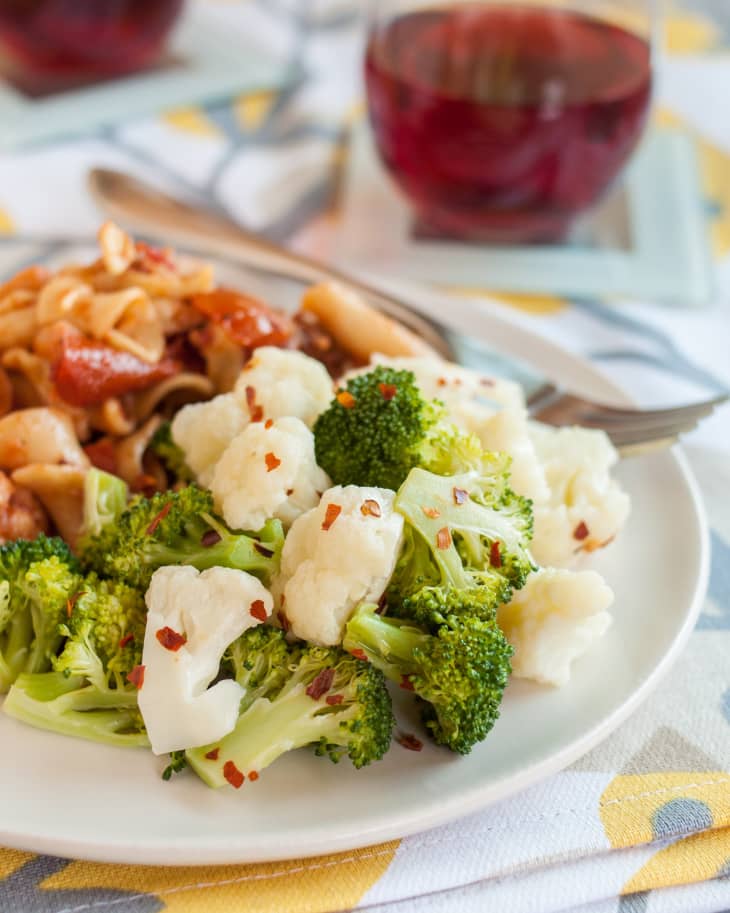How To Steam Vegetables

Steamed vegetables — this is one of the easiest and quickest ways to get vegetables onto our plates. It’s something we can do without needing to think about it too much or make too much effort. We can just let the veggies steam while finishing the rest of dinner and toss them with a little butter before serving. Vegetables, done!
If you’ve been scarred by mushy carrots or sad green beans in the past, I’m here to help. Here’s how to perfectly steam any vegetable in a few easy steps.
Steamed Vegetables: Two Essentials
The key to steaming vegetables is twofold: cut the vegetables into uniform sizes and don’t over-steam them. Pretty logical, right?!
Cut the vegetables into uniform sizes so that they cook at roughly the same rate and are all done at the same time. You can mix vegetables, but be aware that more tender vegetables, like broccoli, will cook faster than denser vegetables, like carrots. If you want to steam mixed vegetables at the same time, add the longer-cooking veggies first and then the quicker-cooking veggies after a few minutes. You can also cut the denser vegetables slightly smaller so that they cook more quickly and finish at the same time as the rest of the vegetables.
My trick for avoiding over-steaming? Set a timer! If I don’t, I’m likely to get distracted with other parts of the meal and forget that the vegetable are steaming away on the back burner. I usually set the timer initially for three minutes, and then continue checking intermittently based on how quickly I think they’re cooking.
I also take the vegetables out of the steamer basket when they still have just a bit of crunch in the middle — by the time I get them to the table, the vegetables have cooked through perfectly without going mushy. Take a look at the guide below for rough cooking times for various vegetables.
Any other steaming tips to share?
How Long to Steam Vegetables
- Spinach and Arugula: 3 minutes
- Peas: 3 minutes
- Broccoli Florets, Cauliflower Florets, Green Beans: 5 to 7 minutes
- Carrots, Potatoes, Turnips, Squash: 8 to 20 minutes
- Kale and Collards: 10 minutes
How To Steam Vegetables
Nutritional Info
Ingredients
Any vegetables: broccoli, cauliflower, carrots, potatoes, green beans, peppers
Equipment
Cutting board
Chef's knife
Small saucepan with lid
Steamer basket
Paring knife
Instructions
-
Cut the vegetables: Cut the vegetables into uniform bite-sized pieces, the way you plan to serve them. Smaller pieces will also cook more quickly than larger pieces.
-
Add 1 inch of water to the pan and insert the steamer basket: Add an inch or two of water to your saucepan. Insert the steamer basket. The surface of the water should be under the basket; pour out some water if necessary.
-
Bring the water to a boil: Bring the water to a boil over high heat. When you hear the water bubbling and see steam starting to emerge from the pot, it's ready.
-
Add the vegetables, cover and reduce the heat: Scatter the vegetables over the steamer basket. Cover the pot and reduce the heat to medium.
-
Steam the vegetables: Start checking the vegetables after a few minutes. Tender vegetables, like broccoli and asparagus, will cook in just a few minutes. Harder vegetables, like carrots and potatoes, will take longer. Smaller pieces will also cook more quickly than larger pieces.
-
Vegetables are done when tender: The vegetables are done when you can easily pierce the thickest part of the vegetable with a paring knife. Most vegetables are also bright and vibrant in color when ready. Stop steaming when the vegetables still have a bit of crunch to them — they will finish cooking in the residual heat.
-
Serve the vegetables: Use the vegetables as directed in your recipe. For a simple side dish, toss the vegetables with a little olive oil or butter, salt, and a squeeze of lemon.
Recipe Notes
This post has been updated. Originally published February 2010.
Want more smart tutorials for getting things done around the home?
See more How To posts
We’re looking for great examples of your own household intelligence too!
Submit your own tutorials or ideas here!
